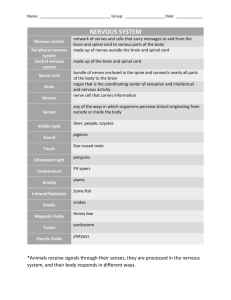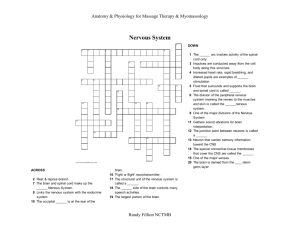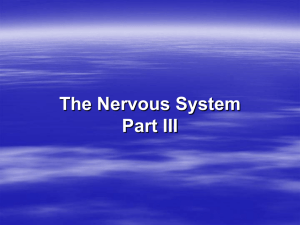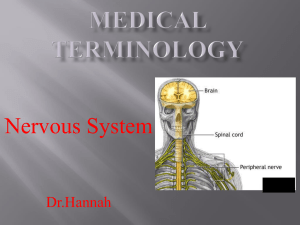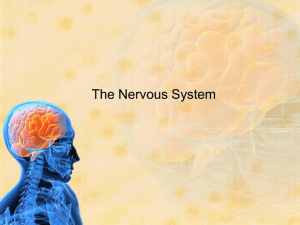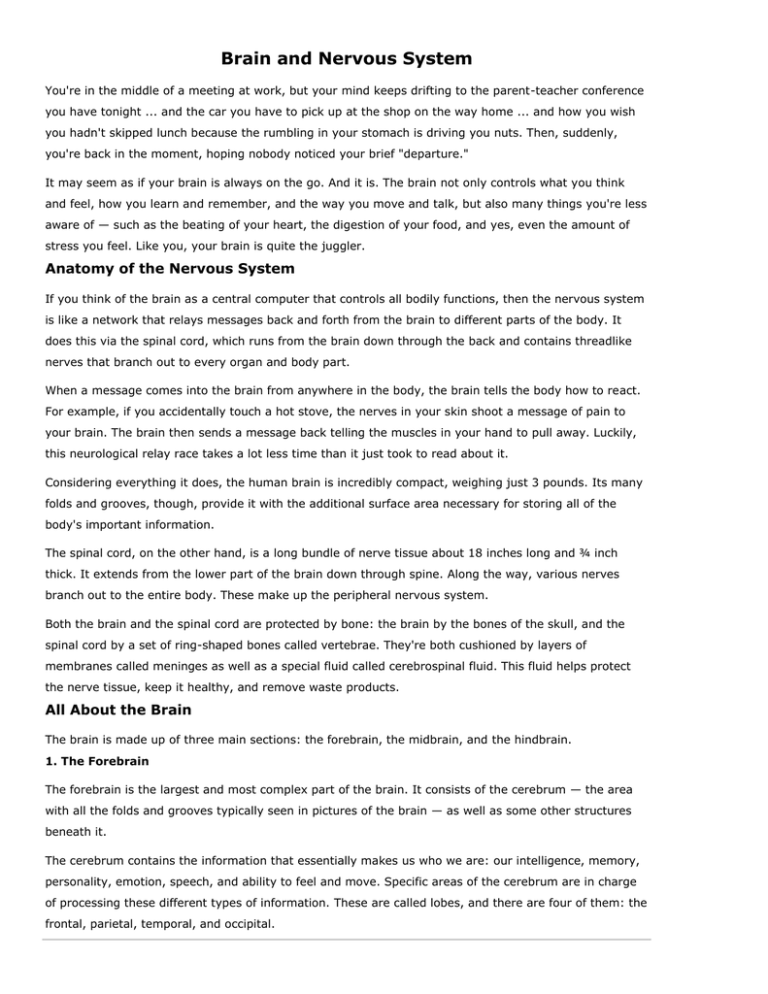
Brain and Nervous System
You're in the middle of a meeting at work, but your mind keeps drifting to the parent-teacher conference
you have tonight ... and the car you have to pick up at the shop on the way home ... and how you wish
you hadn't skipped lunch because the rumbling in your stomach is driving you nuts. Then, suddenly,
you're back in the moment, hoping nobody noticed your brief "departure."
It may seem as if your brain is always on the go. And it is. The brain not only controls what you think
and feel, how you learn and remember, and the way you move and talk, but also many things you're less
aware of — such as the beating of your heart, the digestion of your food, and yes, even the amount of
stress you feel. Like you, your brain is quite the juggler.
Anatomy of the Nervous System
If you think of the brain as a central computer that controls all bodily functions, then the nervous system
is like a network that relays messages back and forth from the brain to different parts of the body. It
does this via the spinal cord, which runs from the brain down through the back and contains threadlike
nerves that branch out to every organ and body part.
When a message comes into the brain from anywhere in the body, the brain tells the body how to react.
For example, if you accidentally touch a hot stove, the nerves in your skin shoot a message of pain to
your brain. The brain then sends a message back telling the muscles in your hand to pull away. Luckily,
this neurological relay race takes a lot less time than it just took to read about it.
Considering everything it does, the human brain is incredibly compact, weighing just 3 pounds. Its many
folds and grooves, though, provide it with the additional surface area necessary for storing all of the
body's important information.
The spinal cord, on the other hand, is a long bundle of nerve tissue about 18 inches long and ¾ inch
thick. It extends from the lower part of the brain down through spine. Along the way, various nerves
branch out to the entire body. These make up the peripheral nervous system.
Both the brain and the spinal cord are protected by bone: the brain by the bones of the skull, and the
spinal cord by a set of ring-shaped bones called vertebrae. They're both cushioned by layers of
membranes called meninges as well as a special fluid called cerebrospinal fluid. This fluid helps protect
the nerve tissue, keep it healthy, and remove waste products.
All About the Brain
The brain is made up of three main sections: the forebrain, the midbrain, and the hindbrain.
1. The Forebrain
The forebrain is the largest and most complex part of the brain. It consists of the cerebrum — the area
with all the folds and grooves typically seen in pictures of the brain — as well as some other structures
beneath it.
The cerebrum contains the information that essentially makes us who we are: our intelligence, memory,
personality, emotion, speech, and ability to feel and move. Specific areas of the cerebrum are in charge
of processing these different types of information. These are called lobes, and there are four of them: the
frontal, parietal, temporal, and occipital.
The cerebrum has right and left halves, called hemispheres, which are connected in the middle by a band
of nerve fibers (the corpus collosum) that enables the two sides to communicate. Though these halves
may look like mirror images of each other, many scientists believe they have different functions. The left
side is considered the logical, analytical, objective side. The right side is thought to be more intuitive,
creative, and subjective. So when you're balancing the checkbook, you're using the left side; when
you're listening to music, you're using the right side. It's believed that some people are more "rightbrained" or "left-brained" while others are more "whole-brained," meaning they use both halves of their
brain to the same degree.
The outer layer of the cerebrum is called the cortex (also known as "gray matter"). Information collected
by the five senses comes into the brain from the spinal cord to the cortex. This information is then
directed to other parts of the nervous system for further processing. For example, when you touch the
hot stove, not only does a message go out to move your hand but one also goes to another part of the
brain to help you remember not to do that again.
In the inner part of the forebrain sits the thalamus, hypothalamus, and pituitary gland. The thalamus
carries messages from the sensory organs like the eyes, ears, nose, and fingers to the cortex. The
hypothalamus controls the pulse, thirst, appetite, sleep patterns, and other processes in our bodies that
happen automatically. It also controls the pituitary gland, which makes the hormones that control our
growth, metabolism, digestion, sexual maturity, and response to stress.
2. The Midbrain
The midbrain, located underneath the middle of the forebrain, acts as a master coordinator for all the
messages going in and out of the brain to the spinal cord.
3. The Hindbrain
The hindbrain sits underneath the back end of the cerebrum, and it consists of the cerebellum, pons, and
medulla. The cerebellum — also called the "little brain" because it looks like a small version of the
cerebrum — is responsible for balance, movement, and coordination.
The pons and the medulla, along with the midbrain, are often called the brainstem. The brainstem takes
in, sends out, and coordinates all of the brain's messages. It also controls many of the body's automatic
functions, like breathing, heart rate, blood pressure, swallowing, digestion, and blinking.
How the Nervous System Works
The basic functioning of the nervous system depends a lot on tiny cells called neurons. The brain has
billions of them, and they have many specialized jobs. For example, sensory neurons take information
from the eyes, ears, nose, tongue, and skin to the brain. Motor neurons carry messages away from the
brain and back to the rest of the body.
All neurons, however, relay information to each other through a complex electrochemical process,
making connections that affect the way we think, learn, move, and behave.
Intelligence, learning, and memory. At birth, the nervous system contains all the neurons you will
ever have, but many of them are not connected to each other. As you grow and learn, messages travel
from one neuron to another over and over, creating connections, or pathways, in the brain. It's why
driving seemed to take so much concentration when you first learned but now is second nature: The
pathway became established.
In young children, the brain is highly adaptable; in fact, when one part of a young child's brain is injured,
another part can often learn to take over some of the lost function. But as we age, the brain has to work
harder to make new neural pathways, making it more difficult to master new tasks or change established
behavior patterns. That's why many scientists believe it's important to keep challenging your brain to
learn new things and make new connections— it helps keeps the brain active over the course of a
lifetime.
Memory is another complex function of the brain. The things we've done, learned, and seen are first
processed in the cortex, and then, if we sense that this information is important enough to remember
permanently, it's passed inward to other regions of the brain (such as the hippocampus and amygdala)
for long-term storage and retrieval. As these messages travel through the brain, they too create
pathways that serve as the basis of our memory.
Movement. Different parts of the cerebrum are responsible for moving different body parts. The left side
of the brain controls the movements of the right side of the body, and the right side of the brain controls
the movements of the left side of the body. When you press the accelerator with your right foot, for
example, it's the left side of your brain that sends the message allowing you to do it.
Basic body functions. A part of the peripheral nervous system called the autonomic nervous system is
responsible for controlling many of the body processes we almost never need to think about, like
breathing, digestion, sweating, and shivering. The autonomic nervous system has two parts: the
sympathetic and the parasympathetic nervous systems.
The sympathetic nervous system prepares the body for sudden stress, like if you see a robbery taking
place. When something frightening happens, the sympathetic nervous system makes the heart beat
faster so that it sends blood more quickly to the different body parts that might need it. It also causes
the adrenal glands at the top of the kidneys to release adrenaline, a hormone that helps give extra power
to the muscles for a quick getaway. This process is known as the body's "fight or flight" response.
The parasympathetic nervous system does the exact opposite: It prepares the body for rest. It also helps
the digestive tract move along so our bodies can efficiently take in nutrients from the food we eat.
The senses. Your spouse may be a sight for sore eyes at the end of a long day — but without the brain,
you wouldn't even recognize him or her. Pepperoni pizza sure is delicious — but without the brain, your
taste buds wouldn't be able to tell if you were eating pizza or the box it came in. None of your senses
would be useful without the processing that occurs in the brain.
Sight. Sight probably tells us more about the world than any other sense. Light entering the eye
forms an upside-down image on the retina. The retina transforms the light into nerve signals for
the brain. The brain then turns the image right-side up and tells us what we are seeing.
Hearing. Every sound we hear is the result of sound waves entering our ears and causing our
eardrums to vibrate. These vibrations are then transferred along the tiny bones of the middle ear
and converted into nerve signals. The cortex then processes these signals, telling us what we are
hearing.
Taste. The tongue contains small groups of sensory cells called taste buds that react to
chemicals in foods. Taste buds react to sweet, sour, salty, and bitter. Messages are sent from the
taste buds to the areas in the cortex responsible for processing taste.
Smell. Olfactory cells in the mucous membranes lining each nostril react to chemicals we
breathe in and send messages along specific nerves to the brain— which, according to experts,
can distinguish between more than 10,000 different smells. With that kind of sensitivity, it's no
wonder research suggests that smells are very closely linked to our memories.
Touch. The skin contains more than 4 million sensory receptors — mostly concentrated in the
fingers, tongue, and lips — that gather information related to touch, pressure, temperature, and
pain and send it to the brain for processing and reaction.
Things That Can Go Wrong With the Brain
Because the brain controls just about everything, when something goes wrong with it, it's often serious
and can affect many different parts of the body. Inherited diseases, brain disorders associated with
mental illness, and head injuries can all affect the way the brain works and upset the daily activities of
the rest of the body.
Problems that can affect the brain include:
Brain tumors. A brain tumor is an abnormal tissue growth in the brain. A tumor in the brain may grow
slowly and produce few symptoms until it becomes large, or it can grow and spread rapidly, causing
severe and quickly worsening symptoms. Brain tumors in children can be benign or malignant. Benign
tumors usually grow in one place and may be curable through surgery if they're located in a place where
they can be removed without damaging the normal tissue near the tumor. A malignant tumor is
cancerous and more likely to grow rapidly and spread.
Cerebral palsy. Cerebral palsy is the result of a developmental defect or damage to the brain before or
during a child’s birth, or during the first few years of life. It affects the motor areas of the brain. A person
with cerebral palsy may have average intelligence or can have severe developmental delays or mental
retardation. Cerebral palsy can affect body movement in many different ways. In mild cases of cerebral
palsy, there may be minor muscle weakness of the arms and legs. In other cases, there may be more
severe motor impairment — a child may have trouble talking and performing basic movements like
walking.
Epilepsy. This condition is made up of a wide variety of seizure disorders. Partial seizures involve specific
areas of the brain, and symptoms vary depending on the location of the seizure activity. Other seizures,
called generalized seizures, involve a larger portion of the brain and usually cause uncontrolled
movements of the entire body and loss of consciousness when they occur. Although the specific cause is
unknown in many cases, epilepsy can be related to brain injury, tumors, or infections. The tendency to
develop epilepsy may be inherited in families.
Headaches. Of the many different types of headaches, the most frequently occurring include tension
headache (the most common type), caused by muscle tension in the head, neck, and shoulders;
migraine, an intense, recurring headache with an unclear cause; and cluster headache, considered by
some to be a form of migraine. Migraines occur with or without warning and may last for several hours or
days. There seems to be an inherited predisposition to migraines as well as certain triggers that can lead
to them. People with migraines may experience dizziness, numbness, sensitivity to light, and nausea,
and may see flashing zigzag lines before their eyes.
Meningitis and encephalitis. These are infections of the brain and spinal cord that are usually caused
by bacteria or viruses. Meningitis is an inflammation of the coverings of the brain and spinal cord, and
encephalitis is an inflammation of the brain tissue. Both conditions may result in permanent injury to the
brain.
Mental illness. Mental illnesses are psychological and behavioral in nature and involve a wide range of
problems in thought and function. Certain mental illnesses are now known to be linked to structural
abnormalities or chemical dysfunction of the brain. Some mental illnesses are inherited, but often the
cause is unknown. Injuries to the brain and chronic drug or alcohol abuse also can trigger some mental
illnesses. Signs of chronic mental illnesses such as bipolar disorder or schizophrenia may first show up in
childhood. Mental illnesses that can be seen in younger people include depression, eating disorders such
as bulimia or anorexia nervosa, obsessive-compulsive disorder (OCD), and phobias.
Head injuries. Head injuries fit into two categories: external (usually scalp) injuries and internal head
injuries. Internal injuries may involve the skull, the blood vessels within the skull, or the brain.
Fortunately, most childhood falls or blows to the head result in injury to the scalp only, which is usually
more frightening than threatening. An internal head injury could have more serious implications because
the skull serves as the protective helmet for the delicate brain.
Concussions are also a type of internal head injury. A concussion is the temporary loss of normal brain
function as a result of an injury. Repeated concussions can result in permanent injury to the brain. One
of the most common reasons kids get concussions is through sports, so it's important to make sure they
wear appropriate protective gear and don't continue to play if they've had a head injury.
Reviewed by: Yamini Durani, MD
Date reviewed: October 2012
Note: All information on KidsHealth® is for educational purposes only. For specific medical advice,
diagnoses, and treatment, consult your doctor.
© 1995- 2014 The Nemours Foundation. All rights reserved.

